Ancient Rome in Algeria: Three North African cities reveal the wealth and depth of the Roman Empire
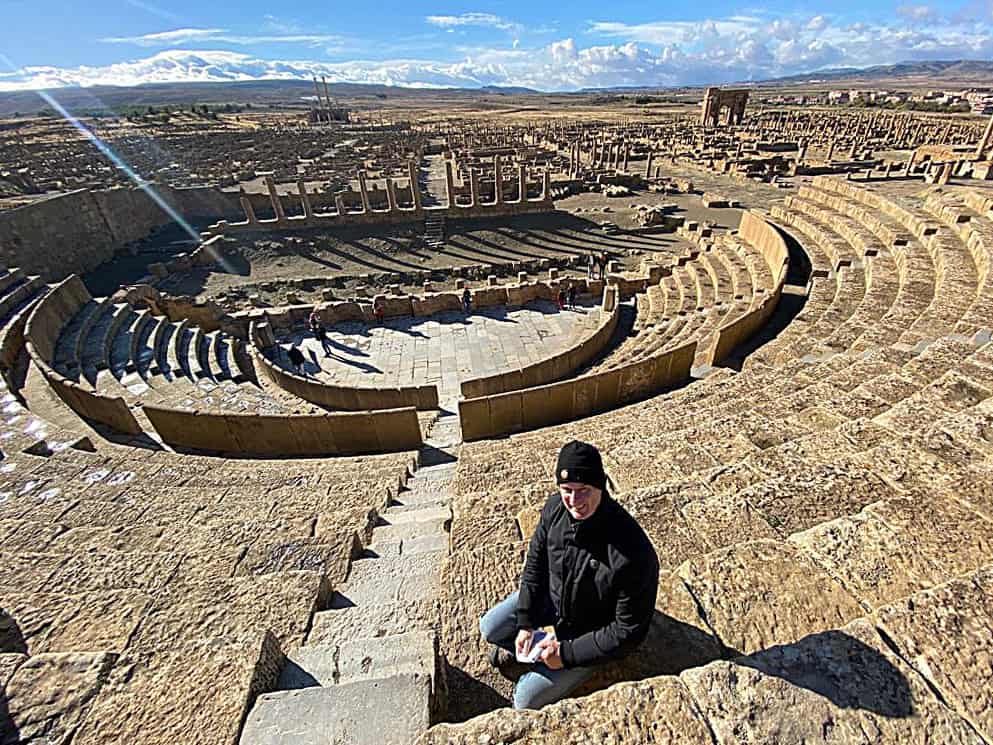
(This is the last of a four-part blog on Algeria.)
CONSTANTINE, Algeria – We had just walked through the remains of a 2,000-year-old church when we saw it. It seemed kind of an odd place for this particular piece of art, regardless of the time period. But there it was, on a wall in the Ancient Roman town of Djemila, around the corner from a house of worship.
A penis.
Yes, the outline of about a nine-inch johnson had been carved in a stone wall. Ero was big in the art of Ancient Rome. I’ve seen similar appendages in Pompeii and Ephesus. It served as a sign that a brothel was nearby. (It was pointing down, not up, I might add, not knowing the symbolism of the flaccidity.)
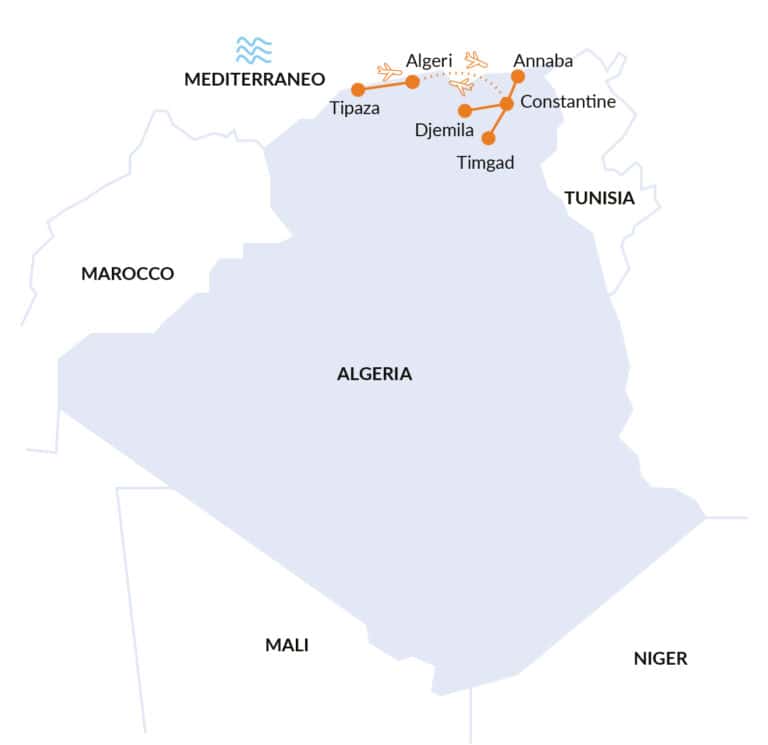
In Djemila, this was the Bacchus House. Bacchus was the god of wine, sex and fertility, moving one group member to ask our guide, kiddingly (I think), “If we touch it, do we become fertile?”
Quipped a female group member, marveling at the member’s impressive size on the wall, “I think someone already has.”

It was always a sign of a wealthy town when it had a healthy brothel. And most of North Africa was wealthy when it was part of Ancient Rome, particularly in Algeria. During my nine-day trip across the country last month with my Travelers’ Century Club (TCC), we visited three Ancient Roman cities. Each one was better preserved than most of what I’ve seen in Italy where I’ve lived for 10 years.
Ancient Rome’s African history
They were three of 600 cities the Ancient Romans established in North Africa. That includes 300 in Algeria, known by the Romans as “the granary of the Empire.”
This trip formulated my new view of the Roman Empire. I’ve seen evidence of Ancient Rome’s campaigns throughout Europe but its forays into North Africa are just as impressive. Even casual Ancient Rome observers know about conquering Carthage, a power since the 9th century B.C., in 146 B.C. True, the Romans vanquished their biggest world threat in the dastardly Hannibal but it was only the beginning.

Rome would rule North Africa for 500 years and the region became the wealthiest province in the Western Roman Empire after the Italian peninsula. Rome had a relatively few 28,000 troops in Northwest Africa, thanks to an open-minded military command that respected the local Berber tribes’ religion and culture. Uprisings were few.
Besides, the Berbers were getting rich.
At one time Northwest Africa produced 1 million tons of cereal every year, one-quarter of which was exported. By the 2nd century A.D., olive oil became a prominent money maker as well as textiles, wine, livestock, timber, pottery, wool and, also, slaves. The wild animals that performed in colosseums around the empire came from North Africa.
As the Roman Empire grew, so did the North African economy. The Romans ruled here until the Germans rolled through in the 5th century with the crude, crass and violent Vandals conquering the area by 439 A.D.
Nearly 1,600 years later, the foundations of these cities remain, providing a glimpse of the prominence and wealth in part of the Roman Empire few have ever seen.
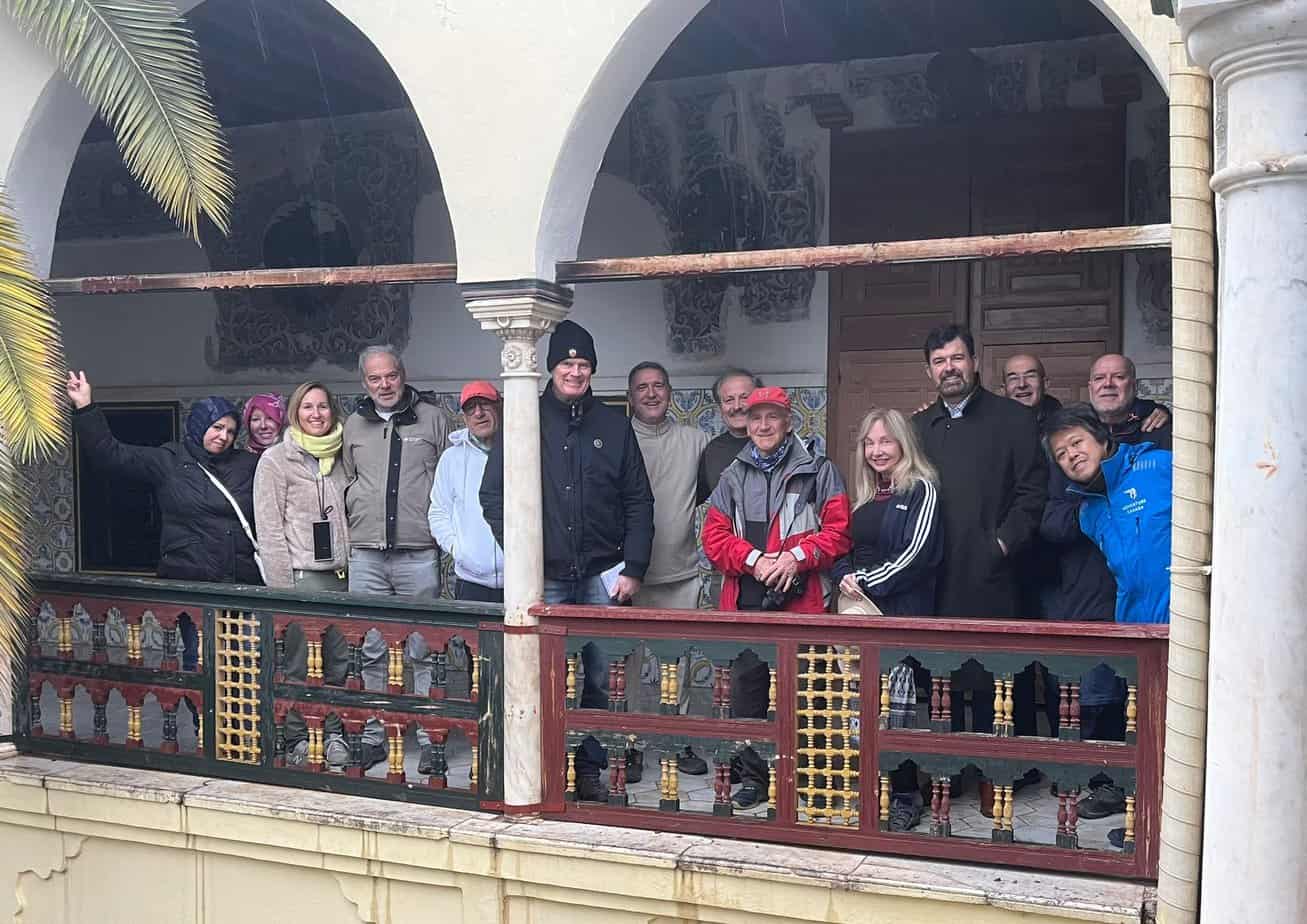
Getting there
Considering our previous itinerary which seemed organized by Santa Claus with late, LATE night flights only bats could appreciate, getting to these sites was relatively sane. We flew out of Ghardaia, Algeria’s most conservative city, at 10:35 p.m. and landed in Constantine at 11:50 p.m.
We stayed at the El Bey Hotel, which made up for its boring location on a drab thoroughfare with modern convenience and a fine though basic restaurant. After camping in the desert one night and fighting for towels, heat and toilet paper in the hotel in Ghardaia, the El Bey felt like a luxurious harem tent minus the girls.
Constantine is about 60 miles (90 kilometers) from the Mediterranean Sea and 200 miles (320 kilometers) east of Algiers. Named for Roman emperor Constantine the Great (306-337 A.D.), the city of 450,000 is the perfect base for exploring Ancient Rome.
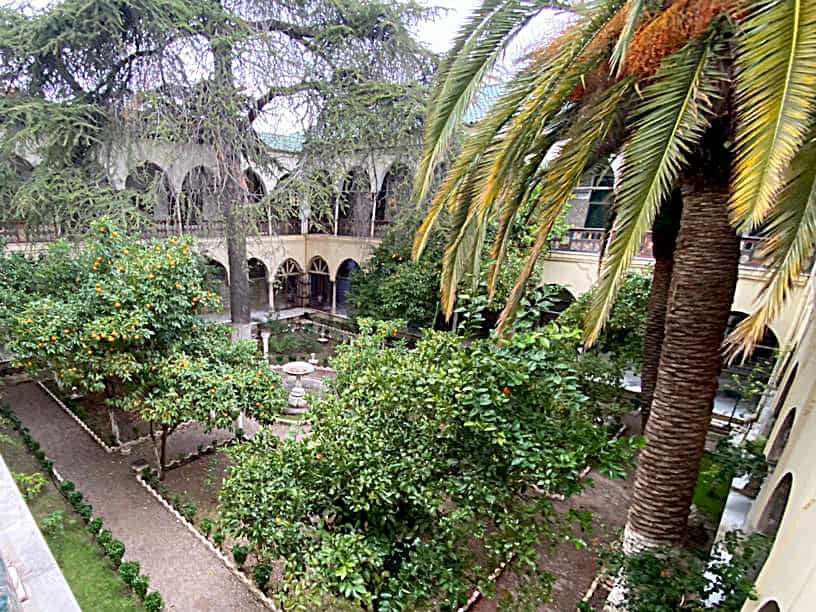
We stopped off at Emir Abdelkader, Constantine’s modern mosque completed in 1994. Its two minarets reach to 106 meters and the inside can hold 15,000 people. We walked through the huge prayer hall and saw men leaning against columns waiting for the imam to give his prayer.
But Constantine was the base, not the destination. Below are the three Ancient Roman cities that should have a more prominent place in history.

Djemila
Djemila was a North African Pompeii without the ash.
From Constantine we drove two hours west through 130 kilometers (70 miles) of the Sahara Desert. It wasn’t the deep desert with sand past your ankles as we saw camping. It was flat, brown and baked, like a giant pie crust. We’d see occasional strips of greenery and trees and sometimes a village would appear.
Like Pompeii, Djemila was rich in culture and wealth with an elaborate societal structure and recreation. Also like Pompeii, Djemila is now a major archaeological site, one of Algeria’s seven on the UNESCO World Heritage list.
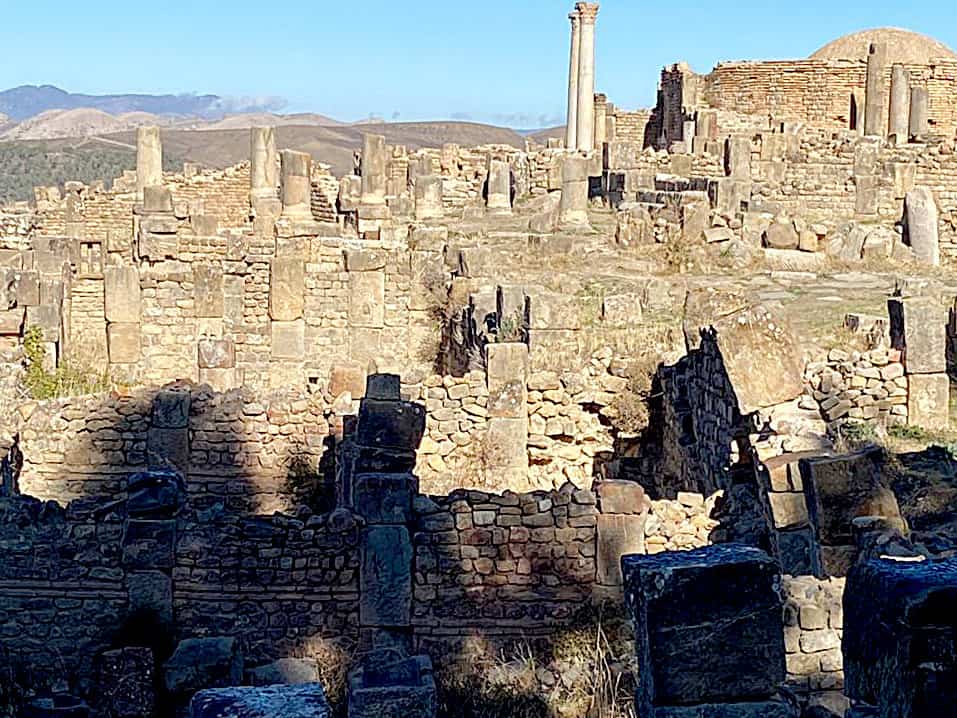
We entered the gate on a crisp 50-degree day and saw a vast field of ruins. Columns of temples stood off in the distance and stone foundations went as far as the eye could see.
Lamila was our guide. Short, pretty and spunky, she wore a hijab covering her hair. I asked her about her country’s treatment of women. She answered as if she gets the question a lot.
“We have equal rights,” she said. “Look. I’m a woman, I’m working and I have three sons.”
She told us the Romans settled here because of the water table underground which produced the fertile lands we were on. They built a city of 100 acres (40 hectares) in two phases: From the 1st-3rd century AD it was pagan; when Christianity became popular it changed in the 4th century.
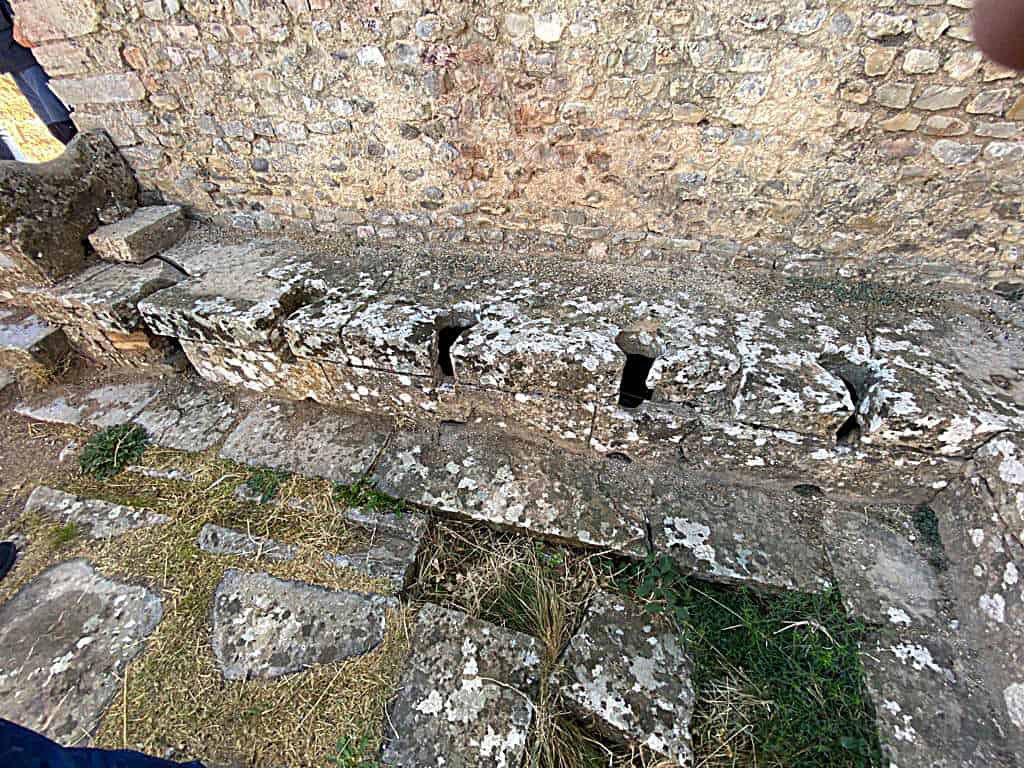
The Romans built 14 bath houses here. One still has the stone seating arranged around a square room with holes provided for you to defecate through. The smell had to be worse than the huge open-air gym next to it. Adjacent to it was a pool that would be big enough for any three-star hotel.
All through my time in Algeria, I was amazed how these ancient civilizations survived in a desert. But in Djemila we passed five reservoirs with walls standing 10 feet high.
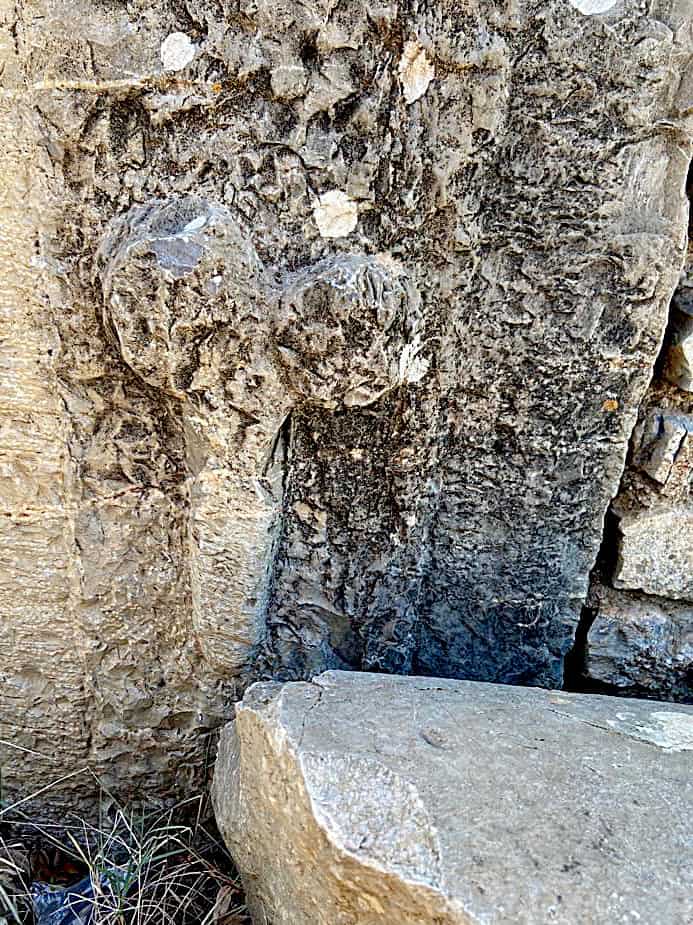
The most impressive structure was the Arch of Caracalla. It’s about the size of the one outside the Roman Colosseum but not as elaborately decorated. But like in Rome, victorious Roman armies marched through it when they returned home.
Topping it all was the Temple of Septimus Severus, the emperor who reigned in the early 3rd century A.D. He was very kind to the natives. He granted them citizenship, gave money to the poor and freed the slaves. When he died in 211, they built a huge temple in his honor. A high staircase leads to an entry hall with six massive, well-preserved columns. The front doors stood 40 feet high.

Djemila also had a big forum where an ubiquitous Temple of Jupiter stood. In the market area, a big stone slab was where they slaughtered animals. A rivet in the stone poured the blood off the slab. A carved plaque shows the silhouette of a man ready to hack the head of a poor sheep, indicating the animal executing ground.
How to get there: Air Algerie has three morning and one evening flight from Algiers to Constantine. The 1-hour, 10-minute flight starts at $18. Djemila is a two-hour drive from Constantine. However, the Algerian government requires permits, guides and a group tour to visit Djemila. TCC used Algeria Tours 16, https://www.facebook.com/Algeriatours16/?_rdc=1&_rdr, algeria.tours16@gmail.com, 213-773-62-0805.
Where to stay: El Bey Hotel, 213-561-92-7334, www.hotelbey.dz, reception@hotelbey.dz. Clean, modern, seven-story hotel on the outskirts of town. Rooms start at €68.
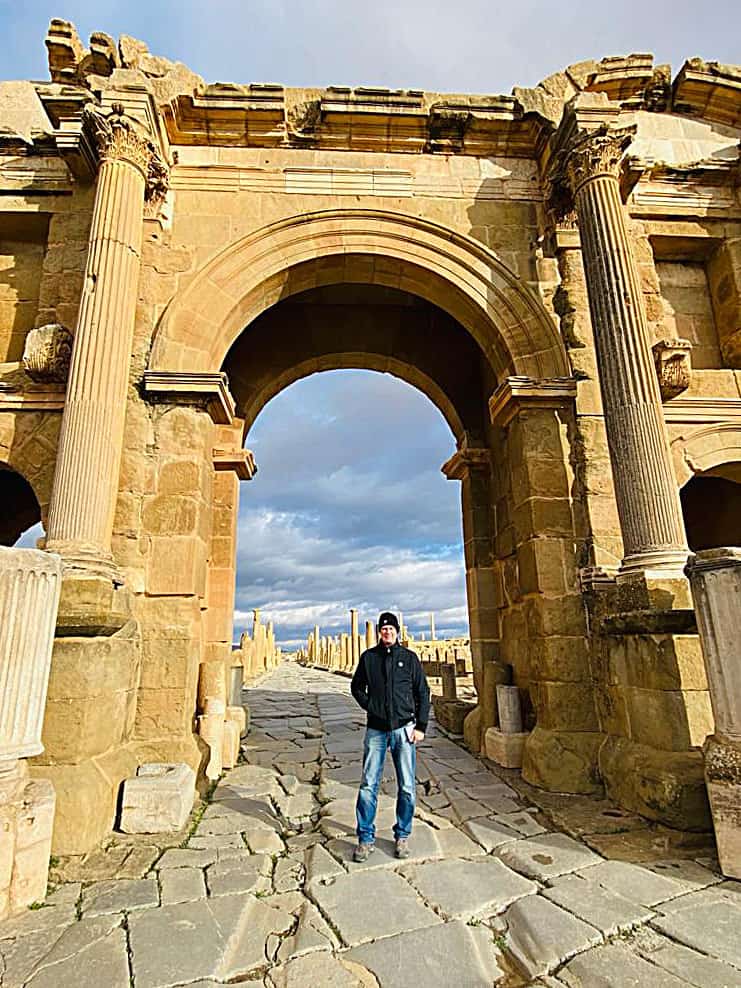
Timgad
The next day, we went south, deeper into the desert. The town of Timbad is 70 miles (120 kilometers) south of Constantine. After visiting Constantine’s Palais Ahmed Bey, a former Ottoman palace where Napoleon once stayed, we took the van past surprisingly large green hills.
This area on the northern edge of the Sahara gets less than one inch of rain a year but every inch of it came down on this one day. It poured when we got off the van but cleared up as we walked around 80 hectares of pristine Roman ruins. Of all the Ancient Roman cities I’ve visited, Timgad may be the best preserved. We could see columns, brick foundations and stone bases everywhere. It looked like God littered the land with giant stones. Beautiful temples and arches dotted the landscape.
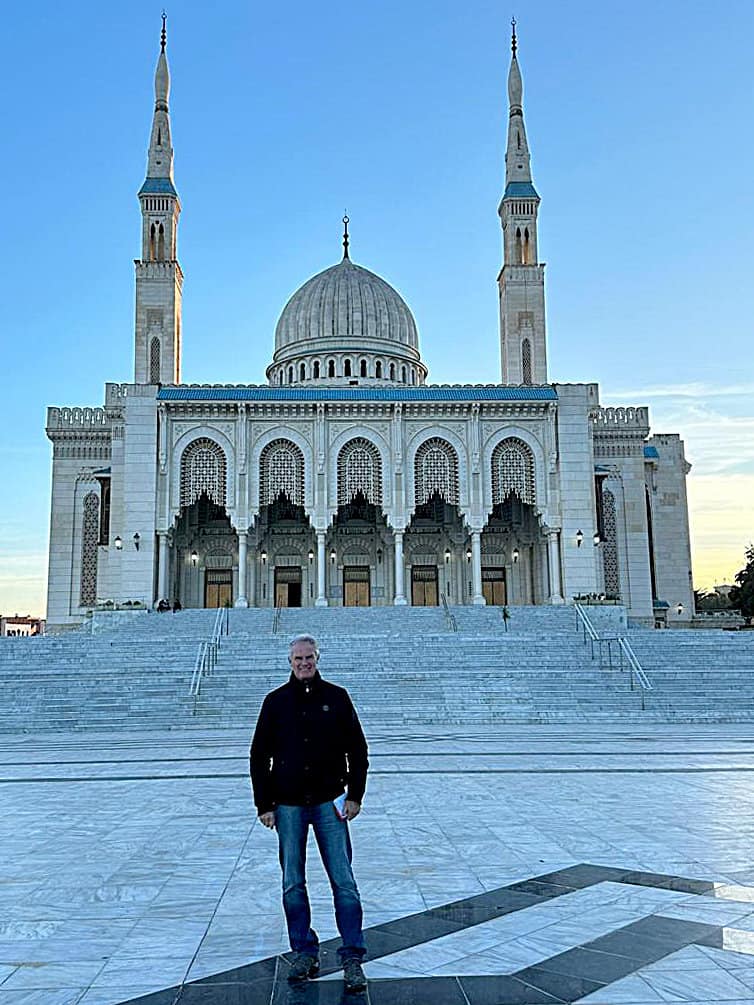
Timgad had a population of 15,000 and had 14 public baths. Emperor Trajan founded the city in 100 AD and his Trajan Arch, standing about 45 meters high with perfectly preserved artwork, is even more beautiful than the one outside the Roman Colosseum.
We walked through a round reading room of a 4th century library where two Dorian columns still stand. The forum was the size of a football field with a temple at one end.
The amphitheater looked like it could hold performances tomorrow. It has 20 rows and could hold 3,000 spectators. They had wrestling competitions, theater and special events. We climbed to the top and could see how far the ruins stretched. This place was massive.
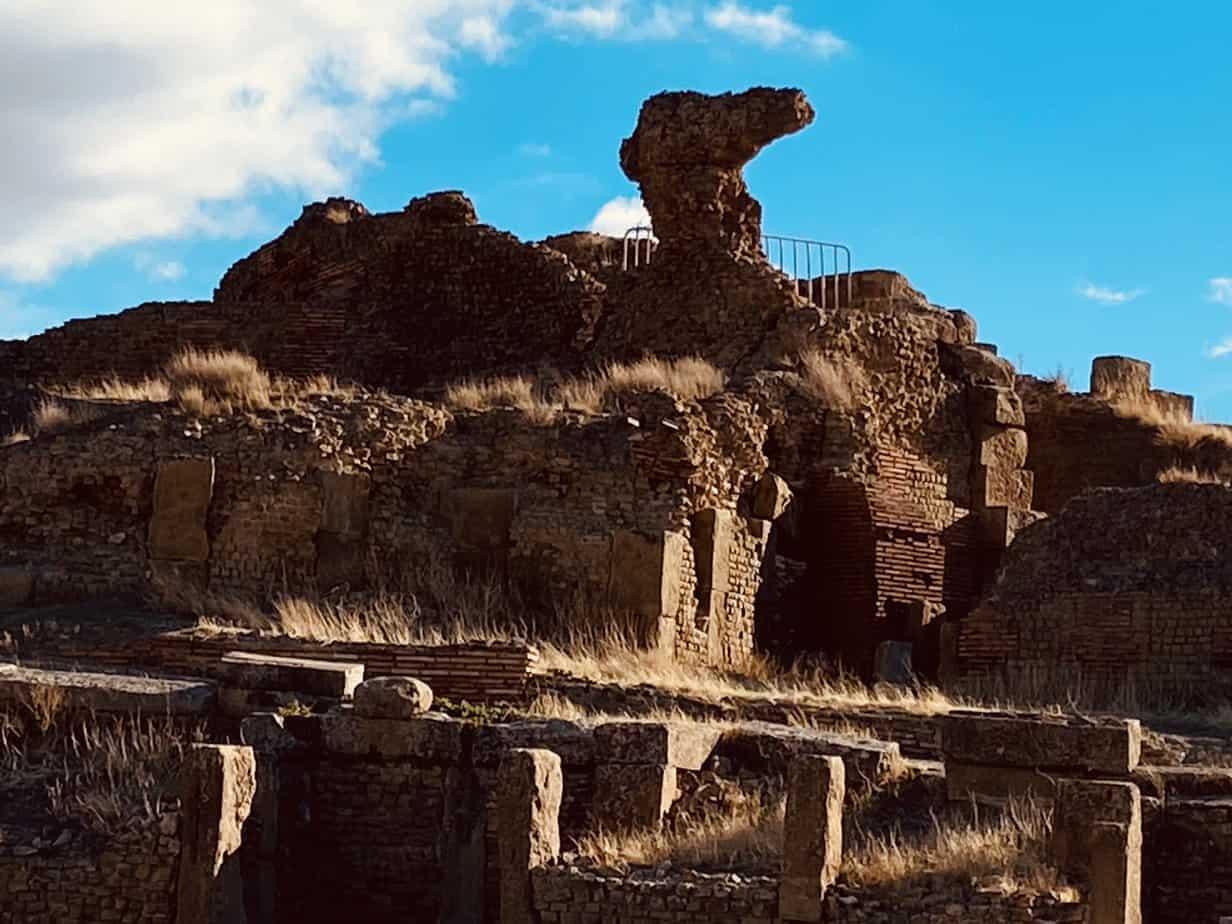
I asked Lumila why they don’t have performances here as they do in Roman amphitheaters like Ephesus and Taormina. She said the government wants to preserve it. So they built a similar one in the city.
Timgad had a second forum where one booth had a sign with grapes carved into it. This was the wine shop. On the other side of the sign was a carving of what is supposed to be Bacchus, looking a little shaky on his feet.
It dawned on me that I had gone a week without a drop of alcohol. Lumila said Algeria has special shops to sell it.
“But isn’t alcohol against the Koran?” I asked.
“Yes, but we’re not all Muslims.°
I said that’s great.
“Half of Algerians live in France so we live like Europeans,” she said. “With open minds.”
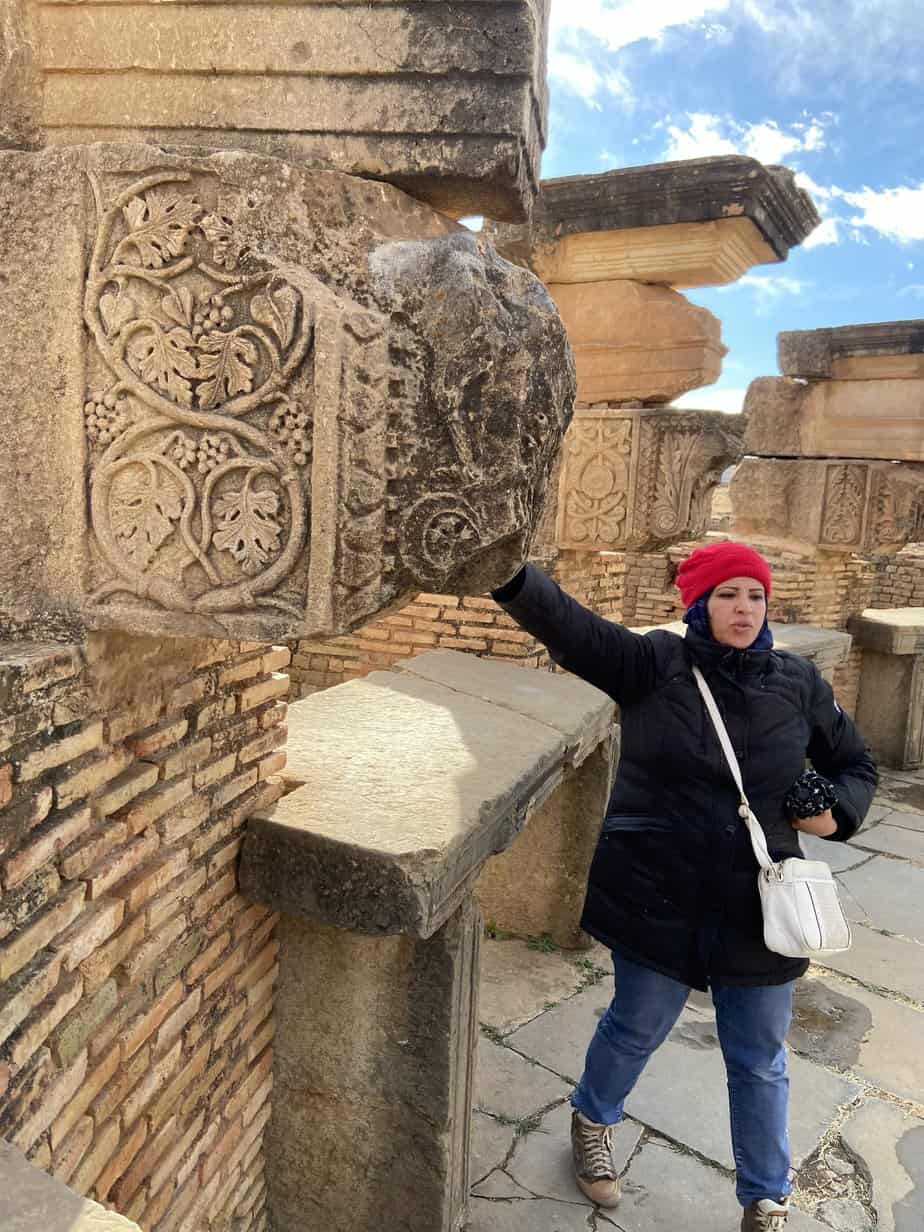
Getting there: Rent a car at Constantine airport. Tidbad is a two-hour drive south of the city. Rentals start at €30 a day.
Tickets: Entry is 120 dinars (about 80 cents).
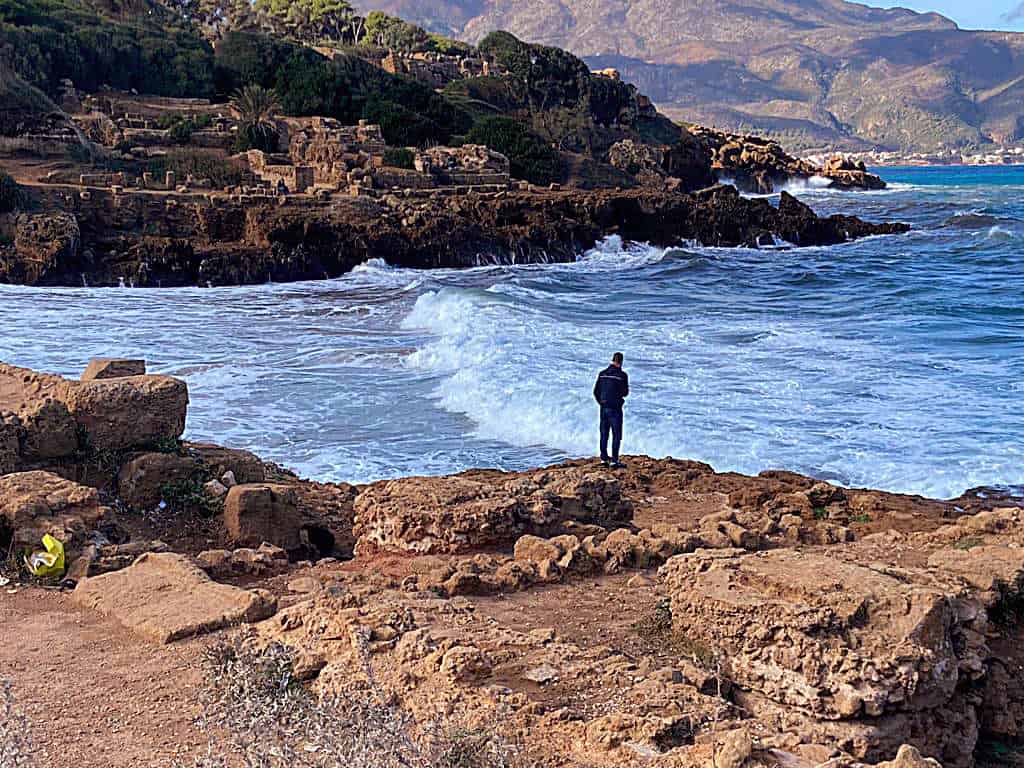
Tipaza
Of all the garden spots in the Roman Empire – and it stretched from what it is now Great Britain to Iraq – Tipaza was one of the top spots for a Roman soldier’s retirement. It is a pretty beach town 40 miles (70 kilometers) west of Algiers.
Our van skirted the beautiful Mediterranean coastline past a cobalt blue sea on one side and fertile farmland on the other. Grape vines reminded me that I had to try Algerian wine before I left in two days.
Founded by the Phoenicians, Tipaza was a Punic trading post before the Romans conquered it and Emperor Claudius turned it into a military colony. The sea provided a natural fortification and the beauty and mild weather attracted a population of 20,000.

Now it’s another UNESCO World Heritage Site. We walked down long, tree-lined streets to the sea where stone foundations of elaborate homes and buildings still stand. The retired soldiers lived on a prime piece of real estate as they had the same views we did: white ocean spray splashing against the rocks on a gentle bend of coastline.
The residential area spanned 1,000 square meters and excavations in the last half of the 20th century unearthed frescoes on walls. Also there are remains of a 4th century church sporting the original blue, red and white mosaics still in place on a floor the size of a basketball court.
With the blue sky, sun and 63-degree weather, we could see how getting sent to North Africa wasn’t a punishment in Ancient Rome.
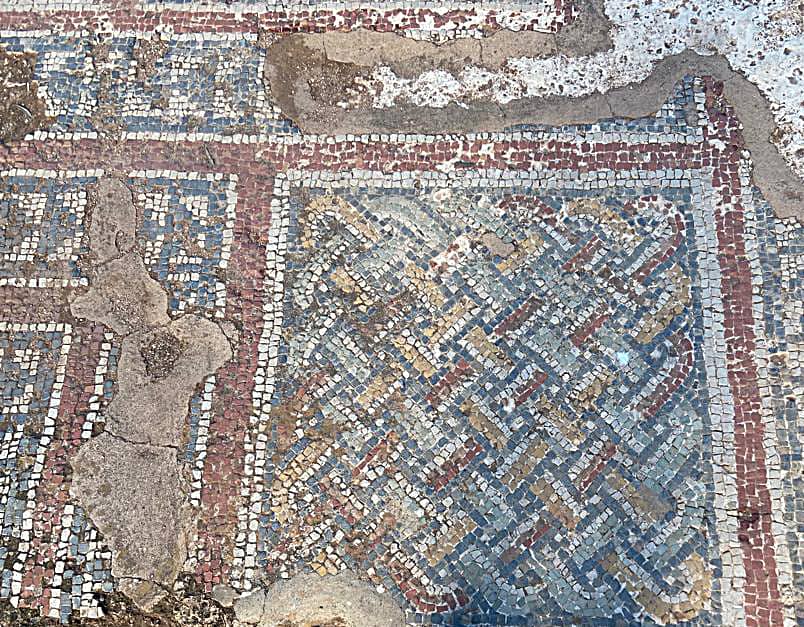
Tipaza was the only site we saw in Algeria with more than a few tourists. We walked past numerous cheap souvenir stands and cheap food stands to Le Dauphin, an open-air restaurant with some of the best seafood on the coast.
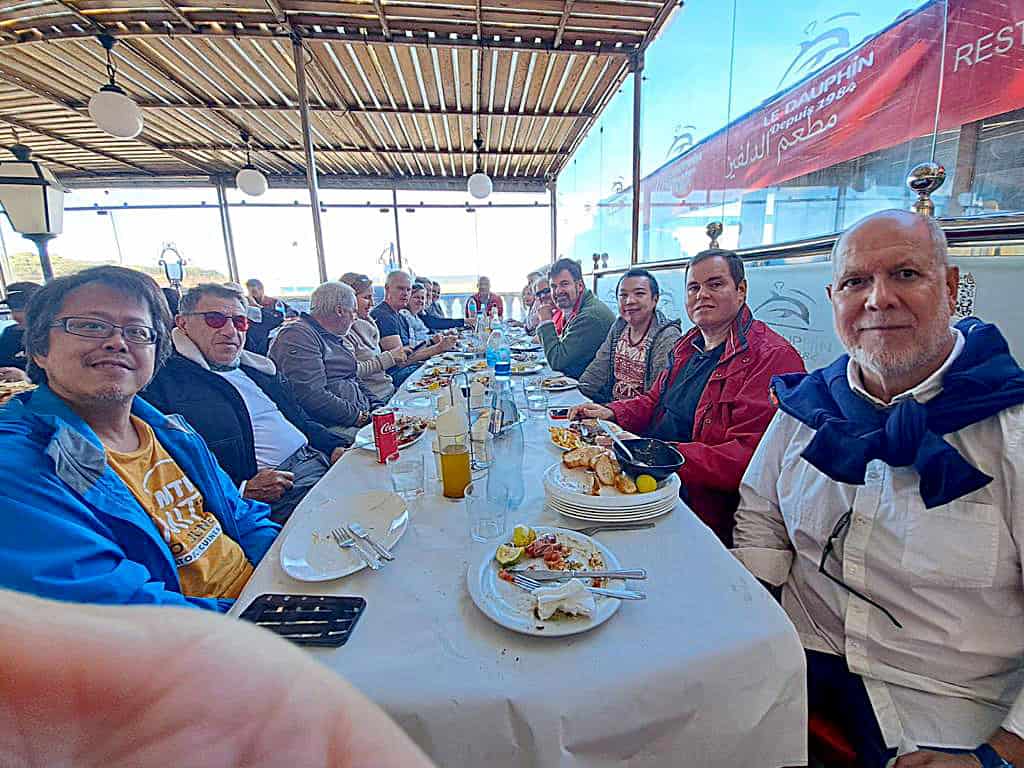
Getting there: Trains leave Algiers every 30 minutes for El Affroun. The 44-minute trip is €1-2. Connection to Tipaza leaves on demand. Trip takes 26 minutes and is €1.
Where to eat: Le Dauphin, 213-770-43-1017, 24 hours. Variety of fresh seafood from the adjacent Mediterranean Sea.
(After three big pieces of dorado and a giant bottle of Coke to share, I sat back, looked at the Algerian coast and jotted down my final impressions of this remarkable country. Here are five bests and worst of Algeria.)

Best of Algeria
- Authenticity. We saw very few tourists. We had archaeological sites to ourselves. I was the only Westerner in Algiers’ casbah. Algeria is battling the paradox of increasing tourism while keeping their culture. Here’s hoping it doesn’t get too popular soon.
- Roman cities. When I saw the trip included trips to Roman ruins, I stifled a yawn. I live in Rome. Turns out they were all more beautiful than anything in Italy.
- The Sahara. I love the size, intimidation and peacefulness of sand as far as you can see with sand dunes shaped like meringue and historical carvings 7,000 years old along the way.
- Prices. Algeria is really cheap. I didn’t pay more than 10 euros for a meal until my last night when I splurged at Algiers’ high-end El Djenina where I paid 11. Taxis are 1-2 euros. The subway is 25 centesimi. A beautiful piece of Berber art for my wall was €20.
- The people. Algerians are so nice. I can’t count how many times I heard, “First time to Algeria? Welcome!” They are very proud of their country. It’s in a good place by African standards and they extend their joy to us.

Worst of Algeria
- Nightlife. There is little to do at night. Islam is different all over the world. You can get in a lot of trouble in Muslim countries like Indonesia, Turkey and even Morocco. I didn’t miss alcohol. I just would’ve liked a place to kick back, relax, read and talk, even with a cup of coffee or tea.
- Money. While I enjoy how it reflects Berber traditions, a cash society is a hassle. You always have to know how much cash you need over a few days. I never used my Visa card. It was accepted nowhere.
- Shopping. Again, this is a reflection of a country that has not sold its soul to tourism. But in an hour in downtown Algiers, I saw two places that sold artwork worthy of a home. It had a plethora of local jewelry stores with really cheap costume jewelry.
- Domestic flights. What the hell? Departures at 2 a.m? Midnight? Who does this? Air Algerie left us all exhausted after only three days.
- One hamburger at lunch. Sorry. This is the best I could come up with. But this was bad. I ate at a covered outdoor table at Noor El Hani, one of the many restaurants lining downtown Algiers. My burger was covered in some gray sauce that poured out of the burger like blood from an open wound after one bite. I needed about four napkins.

